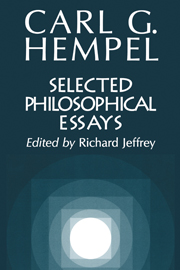Book contents
- Frontmatter
- Contents
- Preface
- Dates
- Introduction
- TRUTH
- Chapter 1 On the Logical Positivists' Theory of Truth
- Chapter 2 Some Remarks on “Facts” and Propositions
- Chapter 3 Some Remarks on Empiricism
- Chapter 4 The Problem of Truth
- Chapter 5 The Irrelevance of the Concept of Truth for the Critical Appraisal of Scientific Theories
- PROBABILITY
- METHODOLOGY
- MEMOIRS
- C. G. HEMPEL'S PUBLICATIONS
- Index
Chapter 1 - On the Logical Positivists' Theory of Truth
Published online by Cambridge University Press: 05 June 2012
- Frontmatter
- Contents
- Preface
- Dates
- Introduction
- TRUTH
- Chapter 1 On the Logical Positivists' Theory of Truth
- Chapter 2 Some Remarks on “Facts” and Propositions
- Chapter 3 Some Remarks on Empiricism
- Chapter 4 The Problem of Truth
- Chapter 5 The Irrelevance of the Concept of Truth for the Critical Appraisal of Scientific Theories
- PROBABILITY
- METHODOLOGY
- MEMOIRS
- C. G. HEMPEL'S PUBLICATIONS
- Index
Summary
This paper has been suggested by a recent discussion between Prof. Schlick and Dr. Neurath, made public in two articles which appeared in volume 4 of Erkenntnis, which mainly concerns the positivistic concept of verification and truth.
For the following exposition it may be advantageous to refer to the well-known crude classification which divides the different theories of truth into two main groups – that is, the correspondence theories and the coherence theories of truth. According to the correspondence-theories truth consists of a certain agreement or correspondence between a statement and the so-called facts or reality; while according to the coherence theories truth is a possible property of a whole system of statements (i.e., a certain conformity of statements with each other). In extreme coherence theories truth is even identified with the mutual compatibility of the elements of such a system.
The logical positivists' theory of truth developed step-by-step from a correspondence theory into a restrained coherence theory.
Let us shortly consider the most important logical phases of this process (which do not exactly correspond to the historical ones).
The philosophical ideas, which L. Wittgenstein has developed in his Tractatus Logico-Philosophicus and which represent the logical and historical starting point of the Vienna Circle's researches, are obviously characterized by a correspondencetheory of truth.
According to one of Wittgenstein's fundamental theses, a statement is to be called true if the fact or state of affairs expressed by it exists; otherwise the statement is to be called false.
- Type
- Chapter
- Information
- Selected Philosophical Essays , pp. 9 - 20Publisher: Cambridge University PressPrint publication year: 2000
- 1
- Cited by



